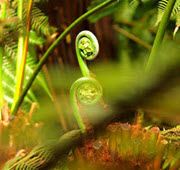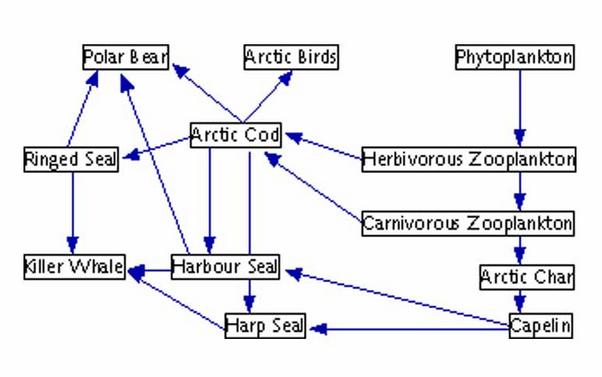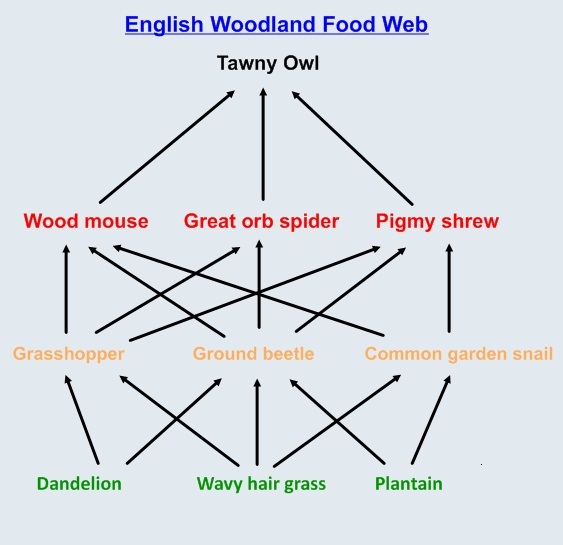Food Webs
 A simple introductory food web activity to review trophic levels and feeding relationships students begins this level and then students complete a card sorting activity to consolidate terms such as heterotroph, carnivore, secondary consumer. These cards are finally used to construct a food web. A super online food webs activity serves as an extension task or an alternative way to illustrate the nature of feeding relationships.
A simple introductory food web activity to review trophic levels and feeding relationships students begins this level and then students complete a card sorting activity to consolidate terms such as heterotroph, carnivore, secondary consumer. These cards are finally used to construct a food web. A super online food webs activity serves as an extension task or an alternative way to illustrate the nature of feeding relationships.
Lesson Description
Guiding Questions
What do the arrows on a food web diagram represent?
Phytoplankton is the only producer in this web, what does that mean?
What is the longest food chain that can be found in this food web? How many species does it contain?
What is the trophic level of an animal like arctic cod, which eats both plants and animals?
Activity 1 - Introduction to trophic levels in a temperate woodland
As an introduction to the classification of animals and plants into trophic levels according to the way they feed, complete this diagram of animals and plants in their trophic levels. Simply open the ![]() Trophic levels presentation in Google slides, make a copy and drag the images of plant and animals into their corresponding boxes.
Trophic levels presentation in Google slides, make a copy and drag the images of plant and animals into their corresponding boxes.
For distance learning. Copy the presentation, ![]() Trophic levels presentation duplicate the slides so there are enough for each student and shared it with your class. By duplicating the slides each student could work on an individual slide all at the same time.
Trophic levels presentation duplicate the slides so there are enough for each student and shared it with your class. By duplicating the slides each student could work on an individual slide all at the same time.
Activity 2 - Complete the feeding relationships photo quiz.
Complete the details on each of the photo cards of animals and plants. The terms are given in the box on the ![]() Feeding Relationships photo quiz worksheet. (photo links in this worksheet are best viewed by clicking the link)
Feeding Relationships photo quiz worksheet. (photo links in this worksheet are best viewed by clicking the link)
Activity 3 - Build a food web using the images from the photo quiz
Using the completed photo cards from activity 2 cut out and arrange the cards onto a piece of A3 paper and connect them using arrows which show the flow of energy from the organism eaten to the consumer. Position the cards carefully to try to avoid having arrows which cross over, if possible.
This is a possible food web.

Activity 4 - Extension activity - Modelling a food web
This ![]() Extra activity- food web simulation illustrates interactions within food webs. Select the species to include in your food chain and decide who eats who. Then run the simulation. By trial and improvement adjust the food web to increase the number of species who survive.
Extra activity- food web simulation illustrates interactions within food webs. Select the species to include in your food chain and decide who eats who. Then run the simulation. By trial and improvement adjust the food web to increase the number of species who survive.
Inquiry question
Robert T. Paine of the University of Washington claimed that, "local species diversity is directly related to the efficiency with which predators prevent the monopolization of the environment by one species.”
To what extent did you find this statement to be true when using this simple model?
.........................................................................................................................
.........................................................................................................................
Teachers notes
The feeding levels or trophic levels of the animals in activity 1 are quite simple to work out, but of course there are one or two animals who feed in different trophic levels at different times of the year. For example the Magpie will eat plants, and also small birds. The toad will feed on plants as a young tadpole. However the activity is to illustrate the idea of trophic levels in food webs.
There is a model answer here, if needed, ![]() Trophic levels model answer
Trophic levels model answer
This diagram is one way to draw the European woodland food web. Of course the images aren't needed in an exam and only 10 organisms are required.
Students should be encouraged to draw food webs of local ecosystems of which they have first hand knowledge.
The research of animals and the feeding habits takes time, and a short field trip or visiting ecologist may be a nice way to include this.

Students will probably ask how to place an organism in it's trophic level if it feeds from more than one trophic level. This is a problem in working out the trophic level. It is less of a problem in the food web diagram because all the links can be shown. Of course ecologists will also look at the proportion of food eaten from each level; an animal that spends all year catching mice and eats berries just for two weeks of the year is probably best classified as a secondary consumer.
I would also like to have a drag and drop quiz linking food web terms for a diagram of energy flow in an ecosystem. This is a project for the coming year.

 IB Docs (2) Team
IB Docs (2) Team

